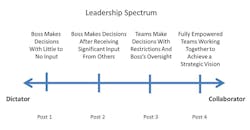This is the second of three articles that will explore a new way of thinking about leadership. The first article looked at some of the differences between managing and leading. This second one explains the "Leadership Spectrum," and the third article will give examples and highlights of other aspects of leadership needed to promote a successful improvement initiative.
Maybe you have heard workers say things like, “My boss is a total dictator! He won’t let anyone make a change without his direct approval!” or “I can’t stand how my boss will never make a decision … always pushing us to figure things out on our own. Why doesn’t he just tell us what to do?” Would you characterize these bosses as being managers or leaders? Maybe the best way to answer this question is to better understand the “Leadership Spectrum.”
Post 1: Boss makes decisions with little or no input.
Pros: Decisions can be made rapidly and decisively. The boss may have additional knowledge about the strategic direction of the organization that others may not be aware of. Also, the boss may be making a difficult decision in order to take the pressure (and responsibility) off of the employees.
Cons: There is little to no ownership and buy-in from anyone other than the decision maker. When things begin to go wrong, there isn’t much incentive to help correct the situation (leading to great delight by the employees who may say something like, “The boss should have known better and asked us for our ideas!”)
The dictator is most effective in a crisis. The analogy I like to use in my training is that if a room begins filling with smoke, everyone would want a dictator to take charge and start telling people what to do. However, a boss who only uses dictator mode can hamper growth in good times when the company starts to expand since they will become the bottleneck when it comes to making decisions. Also, there will be little to no development in the leadership skills of the rest of the organization since they will not be required to take responsibility for any of their actions.
Post 2: Boss makes decisions after receiving significant input from others.
Pros: Decisions are still made decisively and have a greater chance of being correct after receiving input from several diverse sources. The boss can shield employees by taking full responsibility for the decision, especially if there is risk (and hopefully give credit to the employees if things go well).
Cons: Dictators will sometimes try to hide themselves in this leadership style to make it look like they are getting inputs from others when, in reality, the decision has already been made. Also, if the boss has surrounded themselves with "yes" people, then they may think they are getting good, diverse ideas when in fact, all of the inputs are relatively the same (and tend to agree with the boss).
My experience working with Japanese executives is that many of them will use this leadership style. When making a presentation to a Japanese company, for example, the CEO sat at the "place of honor" in the conference room and closed his eyes for most of the meeting. I incorrectly assumed that he was not interested in what I was presenting. However, he actually was paying close attention to what I said as well as the questions and enthusiasm of his staff. At the conclusion of the meeting, after listening to all of the inputs, he stood and said, “Based on everything that has been said today, this is the direction we are going to go,” -- and the decision was made.
Post 3: Teams make decisions with restrictions and boss’s oversight.
Pros: Greater buy-in and support for the decision, especially by those on the team. Diversity of inputs (particularly if the team is cross-functional and includes workers who are closest to the process) helps to assure the best possible decision that everyone will support (consensus). When the boss provides oversight, he/she can assist the team by providing resources, by getting input from other functions/business units, and by helping the team stay focused on strategic initiatives.
Cons: The process of reaching consensus on a decision may be long and tedious. This could bog the team down, resulting in missed deadlines (or rush the decision-making process, if the team feels it is running out of time, resulting in a poorly thought-out solution). Also, the team may try to guess what the boss wants and decide to go in that direction, even if it is incorrect.
For this fencepost on the Leadership Spectrum, the boss becomes the “sponsor” of the team and provides the improvement opportunity, the project scope and parameters (time, funding, resources, etc.), and then only gets involved if the team runs into a roadblock. The boss also connects the team to the overall strategic plan of the company to ensure that they do not drift and start working on something that is not a real need for the organization.
Post 4: Fully empowered teams work together to achieve a strategic vision.
Pros: This style includes formal and informal teams as well as self-directed work teams. Employees get accustomed to working together on improvement initiatives as well as discussing ideas in informal gatherings (shift start up, lunch, etc.). Some of the best ideas bubble up within a group of employees while they are running the process. Once they have gotten accustomed to using the tools and methodologies of lean and Six Sigma, these ideas can quickly be vetted and, where appropriate, implemented.
Cons: This takes a great deal of work and focus by the boss to keep the teams going in a favorable direction. Each time new employees rotate into a work area, for example, fractures can form and the teams can begin to falter. The boss will spend a good bit of their time coaching their employees and working to keep the culture at peak performance. Without this oversight, the teams can begin to drift and work on changes that do not impact the organization’s objectives.
This leadership style requires dedication and commitment to get (and keep) the company culture focused on empowerment, teamwork, trust and support. Comprehensive, consistent communications and the sharing of data, vision and strategy are keys for success. Fear must be driven out (another of Dr. Deming’s 14 points) for this style to be successful… fear of failure, fear to make change happen, and fear to share bad news must all be eliminated.
So, which style would an outstanding leader adopt? The short answer: all of them… even dictator. If the boss understands the importance of each of the above styles, is comfortable flexing to any point on the spectrum, and (most importantly) knows which style is appropriate for a given situation, their chances of being a successful leader are greatly enhanced. In all of my experiences, I have only encountered a few people who fit this description, and in each case they were well respected, trusted by their employees, and helped their organizations achieve greatness.
By the way, I believe that a “manager” tries to manipulate employees through fear, intimidation and coercion. This may be confused with the dictator style of leadership listed above. However, it is more selfish since the manger usually has no intention of shifting to other places on the Leadership Spectrum. They withhold information (knowledge is power), even when decisions are made, and build little trust with their employees. They say things like, “You better do this my way or there will be severe consequences!” The manager might think they are making progress toward achieving greatness, but they usually only are helping the organization stay mired in mediocrity.
Just so there is no confusion, what is the difference between a leader using the dictator side of the Leadership Spectrum (as needed) vs. a manager? A leader uses the dictator style to convey a sense of urgency. They also (if time permits) explain the rationale behind their decisions. Also, they make it clear that they will take full responsibility for anything that might go wrong with their decision, protecting their employees in the process. They also use this style sparingly and only when it is necessary.
My experience with helping organizations starting an improvement initiative from scratch is that the leader usually progresses through all four styles... i.e., "We will improve doing it this way, for these reasons" (Post 1) to "We are going to continue to improve... what should we work on next?" (Post 2) to "Let's form some teams and give them these problems to solve" (Post 3) to "Let's share the vision and data and turn the teams loose to work on the priorities in their area" (Post 4). It is important to go through all four styles to give the culture time to develop, training to be implemented, and trust to be established with the workers. If the leader tries to jump to Post 4 before the employees are ready, then the teams may struggle and the improvement efforts could fall apart.
In the next article, I will share an example (based on actual events) of what the use of the Leadership Spectrum might look like in an organization. We will also cover additional traits that will help a leader be successful in serving an organization to achieve amazing results that might surprise everyone involved (except for maybe the leader themselves).
John Dyer is president of the JD&A – Process Innovation Co. and has 28 years of experience in the field of improving processes. He started his career with General Electric and then worked for Ingersoll-Rand before starting his own consulting company. Dyer can be reached at (704) 658-0049 and [email protected]. And find his profile on Linked In.






